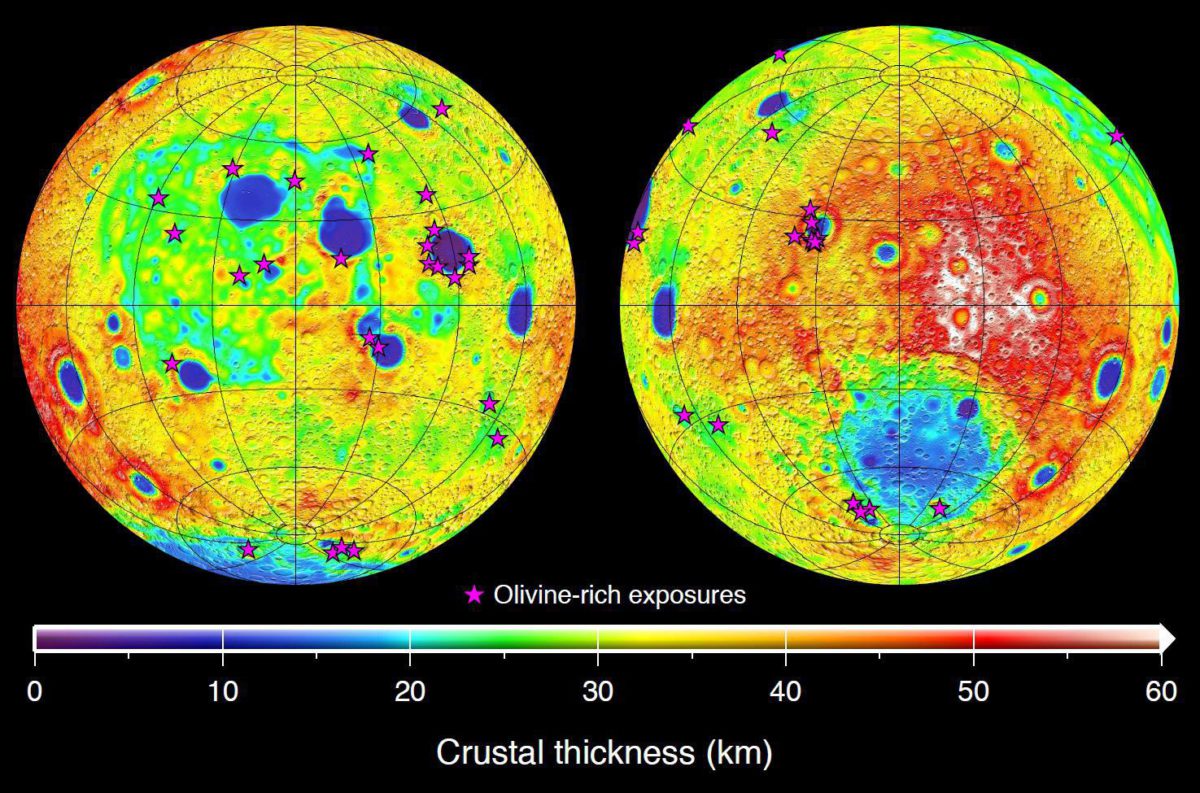Andrew Jones • May 15, 2019
Chang’e-4 may have discovered material from the Moon’s mantle
The first science results from the unprecedented Chang’e-4 lunar far side mission are in. The mission’s Yutu-2 rover, deployed from the lander shortly after the Chang’e-4 landing on 3 January, has, with the help of the Queqiao relay satellite, returned data which suggests it has discovered material derived from the Moon’s mantle, according to research published today in Nature. The possibility of accessing mantle rocks exposed within an enormous impact basin was a major reason for attempting the challenging farside landing.
The Visible and Near Infrared Spectrometer (VNIS) aboard Yutu-2 made the first in situ observations—detecting scattered or reflected light from surface materials—on the lunar far side. These spectra have been interpreted by the paper’s authors to represent the presence of olivine and low-calcium pyroxene, materials that may originate from the Moon’s mantle.
Chang’e-4 set down in the Von Kármán crater within the south pole-Aitken (SPA) basin, an ancient and gigantic 2,500-kilometer-wide, 13-kilometer-deep impact basin which may have penetrated the Moon’s crust and reached the mantle below. It is visible in this GRAIL map of lunar crustal thickness as broad blue spot on the farside.

Von Kármán formed after the SPA basin and was later filled by mare basalt, making a flat floor suitably safe for landing but also covering up the original SPA basin floor. However, after the mare volcanism, the crater Finsen formed nearby. Scientists hoped that Finsen may have excavated some of the mantle-derived basin-floor material and delivered it to Von Kármán in the form of ejecta, where Yutu-2 might examine it close up.

The Yutu-2 VNIS spectra are clearly different from those returned by the same instrument aboard Yutu-1 from the Chang’e-3 mission, which landed in Mare Imbrium on the near side in December 2013, and also differ from spectra of most samples collected from the Moon.
“The initial results of this first farside SPA surface exploration reported in Nature by Li et al. are very exciting and suggest that indeed lunar mantle material may be available on the surface in the SPA area,” says James W. Head, the Louis and Elizabeth Scherck Distinguished Professor of Geological Sciences at Brown University.
“This initial reconnaissance will be further investigated and validated by the continuing and ongoing Chang’e-4 surface exploration, and we look forward to these further results.”
Head also notes that the results could pave the way for a possible far side SPA sample return mission. China’s first sample return mission, Chang’e-5, is currently scheduled to land on the near side close to the end of the year. If successful, Chang’e-6 could then attempt the same same feat from the SPA on the far side.

These are early results and further exploration and detection is needed but, as Patrick Pinet states in his Nature News & Views article on the paper, the results from Li Chunlai and colleagues could have “considerable implications for characterizing the composition of the Moon’s upper mantle,” as well as for determining the characteristics and history of lunar magma ocean, and could even impact understanding of the formation and evolution of planetary bodies.
The paper was submitted in February, meaning it is based only on observations of lunar soil made in the first lunar day of the mission. Chang’e-4 and Yutu-2 have recently concluded their fifth lunar day of activity. During day 3, Yutu-2 was understood to have approached rocks for analysis by VNIS.

The paper states that continued exploration by Yutu-2 will target “materials on the floor of the Von Kármán crater to understand their geologic context, origin and abundance, and to assess the possibility of sample-return scenarios.”
We can also expect more exciting news from Chang’e-4 in the near future. Wang Chi, director of the National Space Science Center under the Chinese Academy of Sciences, says that results from low-frequency radio observations are also expected soon, again taking advantage of the unique environment on the lunar far side.
Lunar day 5 and beyond
Yutu-2 and the Chang’e-4 lander powered down at 03:05 and 04:00 UTC 11 May respectively, bringing activities for lunar day 5 to a close.
No updates were provided regarding the Yutu-2 rover’s noon nap, a 6-day long period of dormancy to protect against the high temperatures with the Sun high in the sky. Instead we learned that Yutu-2 travelled 11.76 meters across day 5, taking the rover’s total mission drive to 190.66 meters.
Drive distances have been decreasing, since covering 120 meters across the first 2 days. Days 3 and 4 saw 43 and 15.9 meters of roving respectively. However, this is no cause for concern for the spacecraft, says Wang Chi.
“The route of Yutu-2 is designed by science goals [while] taking lunar terrain conditions into account,” Wang says. “Yutu-2 works fine so far.”
The rover faces challenging and variable lunar terrain and careful maneuvering is needed when, for example, bringing VNIS to bear on specific specimens, given its narrow field of view.

Sunrise over the Chang’e-4 “Statio Tianhe” landing site will occur on 26 May at around 18:00 UTC. Based on activity from earlier lunar days, Yutu-2 should awaken for mission lunar day 6 around 24 hours later, on 27 May, followed by the lander some 21-24 hours after this.

Let’s Go Beyond The Horizon
Every success in space exploration is the result of the community of space enthusiasts, like you, who believe it is important. You can help usher in the next great era of space exploration with your gift today.
Donate Today

 Explore Worlds
Explore Worlds Find Life
Find Life Defend Earth
Defend Earth

